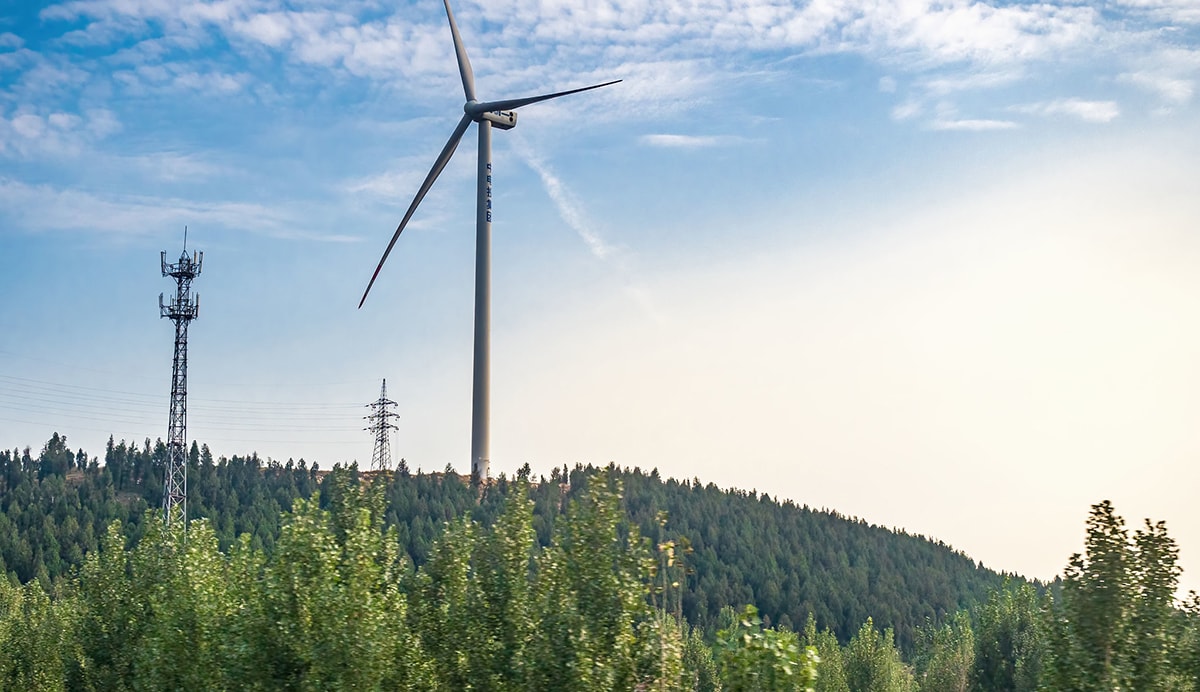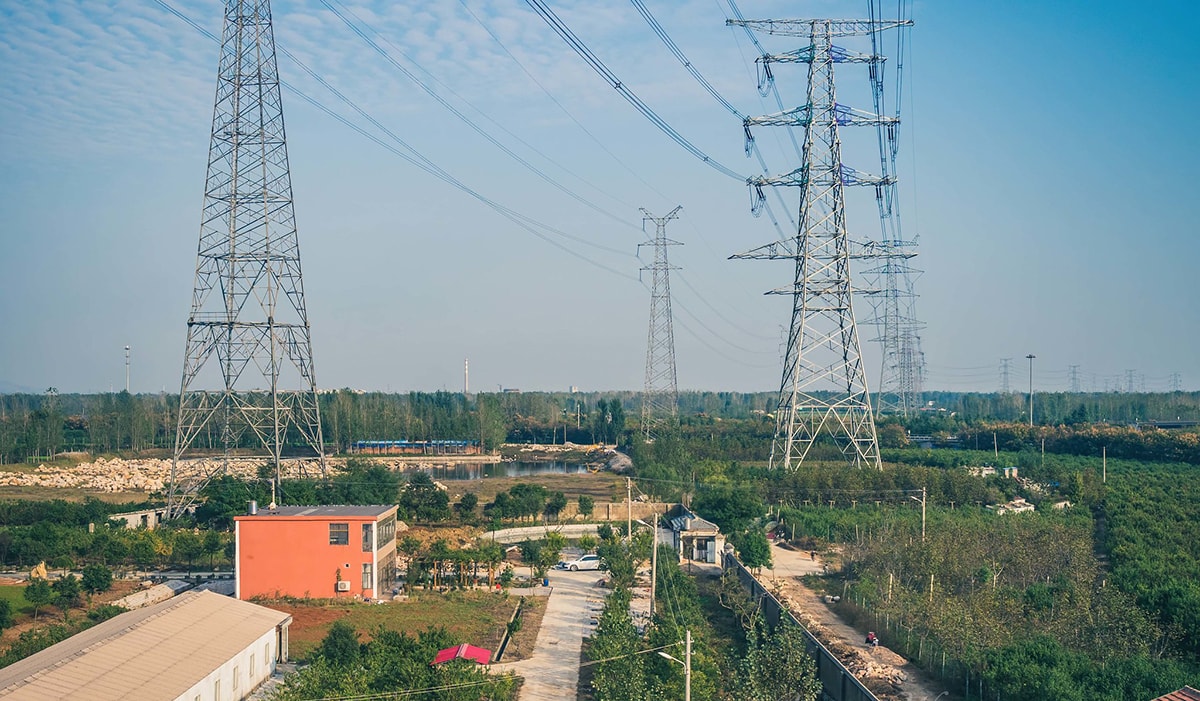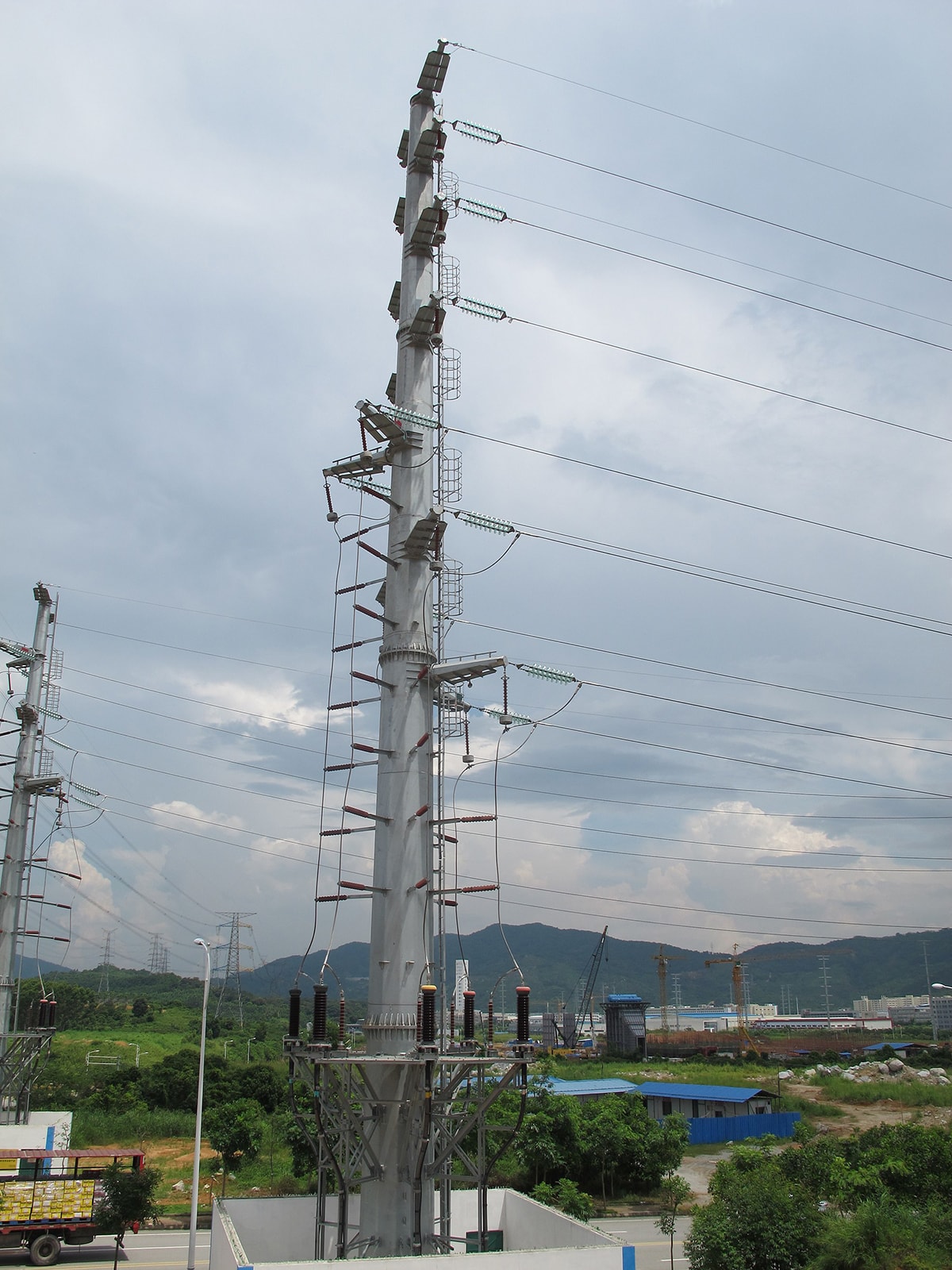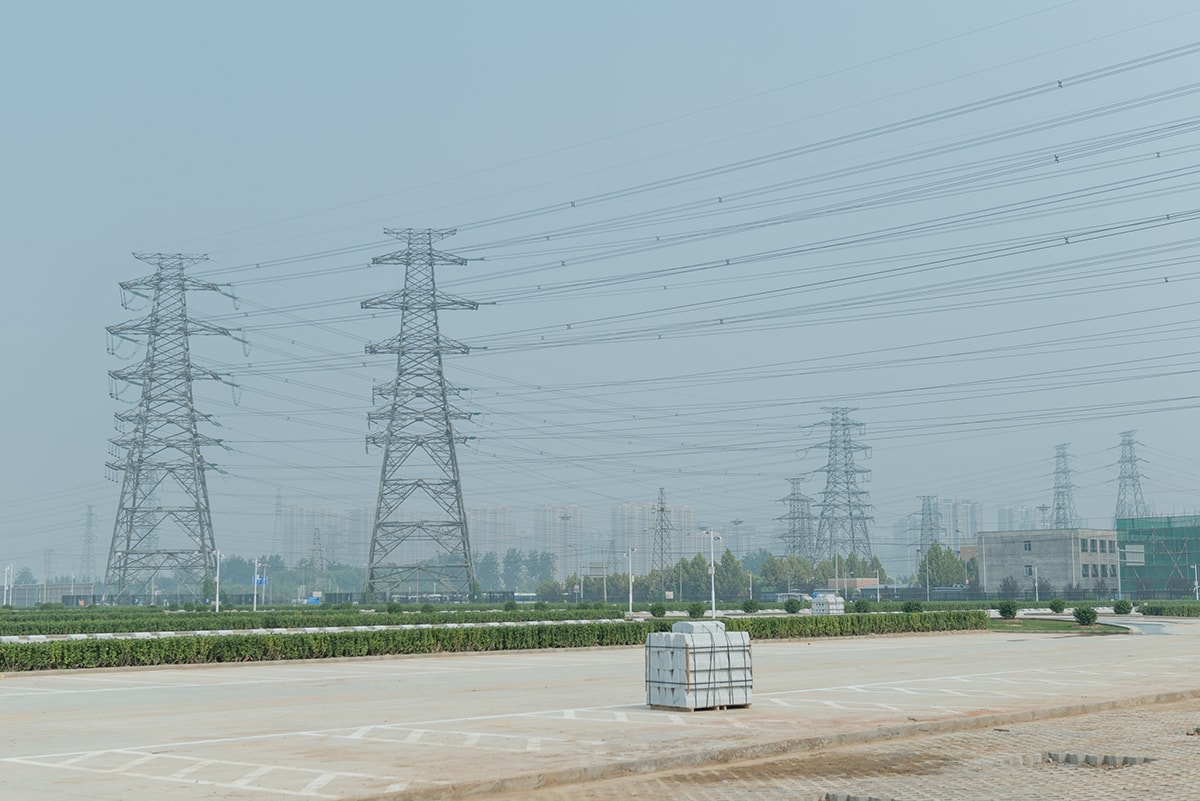In early February, Chinese workers began assembling a soaring red-and-white transmission tower on the eastern edge of the nation’s Anhui province. The men straddled metal tubes as they tightened together latticed sections suspended high above the south bank of the Yangtze River.
The workers were erecting a critical component of the world’s first 1.1-million volt transmission line, at a time when US companies are struggling to build anything above 500,000 volts. Once the government-owned utility, State Grid of China, completes the project next year, the line will stretch from the Xinjiang region in the northwest to Anhui in the east, connecting power plants deep in the interior of the country to cities near the coast.
The transmission line will be capable of delivering the output of 12 large power plants over nearly 2,000 miles (3,200 kilometers), sending 50% more electricity 600 miles further than anything that’s ever been built. (Higher-voltage lines can carry electricity over longer distances with lower transmission losses.) As one foreign equipment provider for the project boasts, the line could ship electricity from Beijing to Bangkok—which, as it happens, only hints at State Grid’s rising global ambitions.
The transmission of power over great distances with high-voltage DC transmission systems reduces the CO2 emissions due to smaller energy losses. But are the country’s next-generation power lines a clean-power play or a global power move? An HVDC power transformer. Photo by Worklife Siemens.
The company initially developed and built ultra-high-voltage lines to meet the swelling energy appetites across the sprawling nation, where high mountains and vast distances separate population centers from coal, hydroelectric, wind, and solar resources. But now State Grid is pursuing a far more ambitious goal: to stitch together the electricity systems of neighboring nations into transcontinental “supergrids” capable of swapping energy across borders and oceans.
These massive networks could help slash climate emissions by enabling fluctuating renewable sources like wind and solar to generate a far larger share of the electricity used by these countries. The longer, higher-capacity lines make it possible to balance out the dimming sun in one time zone with, say, wind, hydroelectric, or geothermal energy several zones away.
Politics and bureaucracy have stymied the deployment of such immense, modern power grids in much of the world. In the United States, it can take more than a decade to secure the necessary approvals for the towers, wires, and underground tubes that cut across swaths of federal, national, state, county, and private lands—on the rare occasion when they get approved at all.
“A long-distance interconnected transmission grid is a big piece of the climate puzzle,” says Steven Chu, the former US energy secretary, who serves as vice chairman of the nonprofit that State Grid launched in 2016 to promote international grid connections. “China is saying ‘We want to be leaders in all these future technologies’ instead of looking in the rear-view mirror like the United States seems to be doing at the moment.”
But facilitating the greater use of renewables clearly isn’t China’s only, or even primary, motivation. Transmission infrastructure is a strategic piece of the Belt and Road Initiative, China’s multitrillion-dollar effort to build development projects and trade relationships across dozens of nations. Stretching its ultra-high-voltage wires around the world promises to extend the nation’s swelling economic, technological, and political power.
Long-distance transmission is a big piece of the climate puzzle. Wind turbine along the train line between Tianjin to Shanghai. Photo by Victor Wong.
23,000 miles of wires
State Grid is probably the biggest company you’ve never heard of, with nearly 1 million employees and 1.1 billion customers. Last year, it reported $9.5 billion in profits on $350 billion in revenue, making it the second-largest company on Fortune’s Global 500 list.
State Grid is already the biggest power distributor in Brazil, where it built its first (and still only) overseas ultra-high-voltage line. The company has also snapped up stakes in national transmission companies in Australia, Greece, Italy, the Philippines, and Portugal. Meanwhile, it’s pushing ahead on major projects in Egypt, Ethiopia, Mozambique, and Pakistan and continues to bid for shares in other European utilities.
“A lot of Chinese companies are very ambitious in spreading overseas,” says Simon Nicholas, a co-author of a report tracking these investments by the Institute for Energy Economics and Financial Analysis, a US think tank. “But State Grid is on another level.”
State Grid was created in late 2002, when the government broke up a massive monopoly, the State Power Corporation of China, into 11 smaller power generation and distribution companies. That regulatory unbundling was designed to introduce competition and accelerate development as the nation struggled to meet rising energy demands and halt recurrent blackouts. But State Grid was by far the larger of two resulting transmission companies, and it operates as an effective monopoly across nearly 90% of the nation.
In 2004, the Communist Party handpicked Liu Zhenya, the former head of Shandong province’s power bureau, to replace the retiring chief executive of State Grid. Liu, a savvy operator with a talent for navigating party politics, almost immediately began to lobby hard for ultra-high-voltage projects, according to Sinews of Power: The Politics of the State Grid Corporation of China by Xu Yi-Chong, a professor at Griffith University in Australia.
Lines capable of sending more energy over greater distances could stitch together the nation’s fragmented grids, instantly delivering excess electricity from one province to another in need, Liu argued. Later, as China came under growing pressure to clean up pollution and greenhouse-gas emissions, State Grid’s rationale evolved: the power lines became a way to accommodate the growing amount of renewable energy generation.
Transmission lines seen from the train from Tianjin to Shanghai. Photo by Victor Wong.
From the start, critics asserted that State Grid was pushing ultra-high-voltage transmission primarily as a means of consolidating its dominant position, or that the new technology was an expensive and risky way of shoring up rickety energy infrastructure.
But Liu’s arguments won out: early projects were approved and built, and party leaders soon prioritized ultra-high-voltage technology in China’s influential five-year plans.
The company at first collaborated closely with foreign firms developing transmission technology, including Sweden’s ABB and Germany’s Siemens, and it continues to buy some equipment from them. But it quickly assimilated the expertise of its partners and began developing its own technology, including high-voltage transformers as well as lines that can function at very high altitudes and very low temperatures. State Grid has also developed software that can precisely control the voltage and frequency arriving at destination points throughout the network, enabling the system to react rapidly and automatically to shifting levels of supply and demand.
The company switched on its first million-volt alternating current line in 2009 and the world’s inaugural 800,000-volt direct current line in 2010. State Grid, and by extension China, is now by far the world’s biggest builder of these lines. By the end of 2017, 21 ultra-high-voltage lines had been completed in the country, with four more under construction, Liu said during a presentation at Harvard University in April.
Collectively, they’ll stretch nearly 23,000 miles and be capable of delivering some 150 gigawatts of electricity—roughly the output of 150 nuclear reactors.
At the end of last year, China had poured at least 400 billion yuan ($57 billion) into the projects, according to Bloomberg New Energy Finance. After a slowdown in new project approvals during the last two years, China’s National Energy Administration said in September that it will sign off on 12 new ultra-high-voltage projects by the end of 2019.
“The fact of the matter is, the Chinese are the only ones seriously building it at this point,” says Christopher Clack, chief executive of Vibrant Clean Energy and a former researcher with the US National Oceanic and Atmospheric Administration. In a study published in Nature in 2016, Clack found that using high-voltage direct-current lines to integrate the US grid could cut electricity emissions to 80% below 1990 levels within 15 years (see “How to get Wyoming wind to California, and cut 80% of US carbon emissions”).
The common destiny of mankind — high-voltage goes global. An underground-to-overhead connection in Guangzhou, China. Photo by Harbindave.
Going Global
In late February of 2016, Liu walked to the lectern at an energy conference in Houston and announced an audacious plan: using ultra-high-voltage technology to build an energy network that would circle the globe.
By interconnecting transmission infrastructure across oceans and continents, in much the way we’ve intertwined the internet, the world could tap into vast stores of wind power at the North Pole and solar along the equator, he said. This would clean up global electricity generation, cut energy costs, and even ease international tensions.
“Eventually, our world will turn into a peaceful and harmonious global village, a community of common destiny for all mankind with sufficient energy, blue skies, and green land,” he said.
Of course, such a global grid won’t happen. It would cost more than $50 trillion and require unprecedented—and unrealistic—levels of international trust and cooperation. Moreover, few nations are clamoring for these kinds of high-voltage lines even within their boundaries.
A handful of countries already exchange electricity through standard transmission lines, but efforts to share renewable resources across wide regions have largely gone nowhere. Among the notable failures is the Desertec Industrial Initiative, an effort backed by Siemens and Deutsche Bank a decade ago to power North African, Middle Eastern, and European electricity grids with solar power from the Sahara.
But State Grid’s global grid plan is basically a sales pitch for its long-distance transmission lines, promoting them as a fundamental enabling technology for the clean-energy transition. If all the company ever achieves are the opening moves in the vision of global interconnectivity, and it develops regional grids connecting a handful of nations, it could still make a lot of money.
Notably, at a conference in Beijing the month after Liu’s speech, the company signed a deal with Korea Electric Power, Japan’s Softbank, and Russian power company Rosseti to collaborate on the development of a Northeast Asian “supergrid” connecting those nations and Mongolia.
Softbank boss Masayoshi Son had proposed a version of the supergrid independent of State Grid back in 2011, after the Fukushima nuclear catastrophe underscored the fragility of Japan’s electricity sector.
Kenichi Yuasa, a spokesperson for the conglomerate, said feasibility studies completed in 2016 and 2017 showed that grid connections between Mongolia, China, Korea, and Japan, as well as a route between Russia and Japan, are both “technically and economically feasible.” “We, as a commercial developer, are ready to execute the projects and would like to deliver tangible progress before Tokyo Olympics in 2020,” he said in an e-mail.
In a response to inquiries from MIT Technology Review, State Grid disputed the argument that the broader global interconnection plan won’t happen, or that its driving motivations are primarily financial and geopolitical.
“The great success of UHV technology application in China represents a major innovation of power transmission technology,” the company said in a statement. “State Grid would like to share this kind of technological innovation with the rest of the world, addressing a possible solution to vital concerns for humankind for example, environmental pollution, climate change, and lack of access to electricity supply.”
Paving the road to the future? Power lines in Beijing. Photo by Tauno Tõhk.
Cleaning up or cleaning up?
In fact, though China has built far more ultra-high-voltage lines than any other country in the world, its own grid is still something of a mess. The country is struggling to efficiently balance its power production and demand, and to distribute electricity where and when it is needed. One result is that it isn’t making full use of its existing renewable-power plants. A recent MIT paper noted that China’s rates of renewable curtailment—the term for when plants are throttled down because of inadequate demand—are the highest in the world and getting higher.
Part of the problem is that it’s easier and more lucrative to use “predictable electrons” from sources like coal or nuclear, which provide a constant stream of electricity, than the variable generation from renewables, says Valerie Karplus, former director of the Tsinghua-MIT China Energy and Climate Project. Mandatory quotas for fossil-fuel plants and provincial politics also distort allocation decisions, she adds.
Less than half of the ultra-high-voltage lines built or planned to date in China are intended to transmit electricity from renewable sources, according to a late-2017 report by Bloomberg New Energy Finance.
“Getting the most out of wind, solar, and other intermittent sources will require rethinking how to make grid operations more flexible and responsive,” Karplus said in an e-mail.
Despite its purported green ambitions, State Grid itself has resisted the broader market reforms that would be necessary to lessen China’s dependence on fossil-fuel plants. All of which raises questions about the company’s commitment to cutting greenhouse-gas emissions, and how much the long-distance lines will really help to clean up power generation elsewhere.
Tellingly, State Grid’s main target markets are in poor countries where fossil-fuel plants dominate and Chinese companies are busy building hundreds of new coal plants. So there’s little reason to expect that any ultra-high-voltage lines built there would primarily carry energy from renewable sources anytime soon.
“I haven’t seen anything that would make me think this is part of a green-development initiative,” says Jonas Nahm, who studies China’s energy policy at the Johns Hopkins School of Advanced International Studies. “I think State Grid just wants to sell these things anywhere and dominate with its own standards over those developed by Siemens and other companies.”
He believes State Grid’s broader ambitions are tied to the Belt and Road Initiative, through which China’s state banks are plowing trillions into infrastructure projects across Asia and Africa in an effort to sell Chinese goods and strengthen the country’s geopolitical influence. Building, owning, or operating another nation’s critical infrastructure—be it seaports or transmission lines—offers a particularly effective route to exercise soft and sometimes not-so-soft power. “This is really a battle over the developing world,” Nahm says.
This article was originally published in MIT Technology Review, on Nov 8, 2018.
James Temple is the senior editor for energy at MIT Technology Review, focused on renewable energy and the use of technology to combat climate change.
Cite
James Temple, “China’s Giant Transmission Grid Could be the Key to Cutting Climate Emissions,” Scenario Journal 07: Power, January 2020. https://scenariojournal.com/article/giant-transmission/





